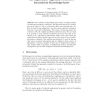Free Online Productivity Tools
i2Speak
i2Symbol
i2OCR
iTex2Img
iWeb2Print
iWeb2Shot
i2Type
iPdf2Split
iPdf2Merge
i2Bopomofo
i2Arabic
i2Style
i2Image
i2PDF
iLatex2Rtf
Sci2ools
JELIA
2000
Springer
2000
Springer
An Algorithmic Approach to Recover Inconsistent Knowledge-Bases
Abstract. We consider an algorithmic approach for revising inconsistent data and restoring its consistency. This approach detects the\spoiled" part of the data (i.e., the set of assertions that cause inconsistency), deletes it from the knowledge-base, and then draws classical conclusions from the \recovered" information. The essence of this approach is its coherence with the original (possibly inconsistent) data: On one hand it is possible to draw classical conclusions from any data that is not related to the contradictory information, while on the other hand, the only inferences allowed by this approach are those that do not contradict any former conclusion. This method may therefore be used by systems that restore consistent information and are obliged to their resource of information. Common examples of this case are diagnostic procedures that analyse faulty components of malfunction devices, and database management systems that amalgamate distributed knowledge-bases. 1 Mo...
Algorithmic Approach | Artificial Intelligence | Classical Conclusions | Inconsistent Data | JELIA 2000 |
Related Content
| Added | 25 Aug 2010 |
| Updated | 25 Aug 2010 |
| Type | Conference |
| Year | 2000 |
| Where | JELIA |
| Authors | Ofer Arieli |
Comments (0)

